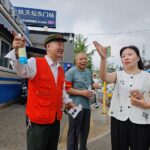People of All Ethnic Groups Share the Fruits of Reform and Development, with Key Economic Indicators Leading the Nation
This year marks the 60th anniversary of the establishment of the Tibet Autonomous Region. On August 5, at a press conference held by the State Council Information Office, the achievements in Tibet’s economic and social development were highlighted.
“Today, Tibet enjoys social stability, economic growth, ethnic unity, religious harmony, ecological preservation, border security, and a thriving population,” it was stated. “History has proven that only under the leadership of the Communist Party of China, by steadfastly following the path of socialism with Chinese characteristics, upholding and improving the system of regional ethnic autonomy, and adhering to the Party’s policies for Tibet in the new era, has Tibet achieved prosperity today and will continue to flourish in the future.”
Expanding Economic Scale with Improved Quality and Efficiency
In 2024, Tibet’s GDP reached 276.5 billion yuan, a 155-fold increase from 1965 in constant prices. “It took 50 years to reach the first 100 billion yuan in GDP, but only six years to achieve the second 100 billion yuan,” it was noted.
“Since 2021, Tibet’s economy has expanded significantly, with marked improvements in quality and efficiency. Emerging industries such as clean energy, cultural tourism, and plateau light industry have flourished, establishing a modern industrial framework. Key economic indicators have consistently ranked among the top in the nation, and this year, GDP is expected to surpass 300 billion yuan, reaching the third 100-billion milestone.”
Infrastructure has seen continuous improvement. By the end of 2024, Tibet’s total road mileage reached 124,900 kilometers, railway operations extended to 1,359 kilometers, and domestic and international flight routes totaled 183. Four major power grids—Qinghai-Tibet, Sichuan-Tibet, Central Tibet, and Ngari—are now operational, covering all counties (districts, cities). “Bottlenecks hindering Tibet’s economic and social development have been significantly alleviated, injecting strong vitality into high-quality growth.”
The cultural and tourism industries are thriving. “Tibet boasts a rich history, unique natural landscapes, and diverse cultural heritage, making it a key site for preserving ethnic culture and a premier global tourist destination,” it was emphasized.
In 2024, cultural industry output grew by 23.8%, with 63.89 million domestic and international tourists, a 15.8% increase, including a 188.2% surge in inbound visitors. In the first half of this year, tourist arrivals reached 32.1848 million, up 11.7% year-on-year.
Greater Sense of Gain, Happiness, and Security
In 2024, urban per capita disposable income reached 55,444 yuan, 121 times that of 1965, while rural per capita disposable income hit 21,578 yuan, a 199-fold increase. “People of all ethnic groups now enjoy stable housing, employment, elderly care, education, and healthcare, sharing the benefits of reform and development with a stronger sense of fulfillment, happiness, and security.”
Living standards have significantly improved. Absolute poverty has been eradicated, and 15 years of free education from kindergarten to high school have been implemented. Traditional culture is preserved and promoted, while public healthcare services have expanded, with rural health checkups covering all residents. Average life expectancy has risen to 72.5 years. Urbanization has accelerated, with modern towns emerging across the plateau. Social security systems have been strengthened, ensuring basic livelihoods.
Over the past 60 years, especially the last five, Tibet has vigorously advanced livelihood projects. “Life has transformed from carrying water buckets to piped water, oil lamps to electric lights, dirt roads to paved ones, and tents to modern buildings.”
During the 14th Five-Year Plan period, 28 categories of social programs were launched, with a total investment of 24.65 billion yuan, of which 23.678 billion has been allocated. High-altitude heating and oxygen supply, seasonal water shortages in rural areas, and unreliable power supply have been addressed, while fiber-optic broadband and 4G networks now cover the entire region.
“People are now enjoying a high-quality life driven by high-quality development.”
One



